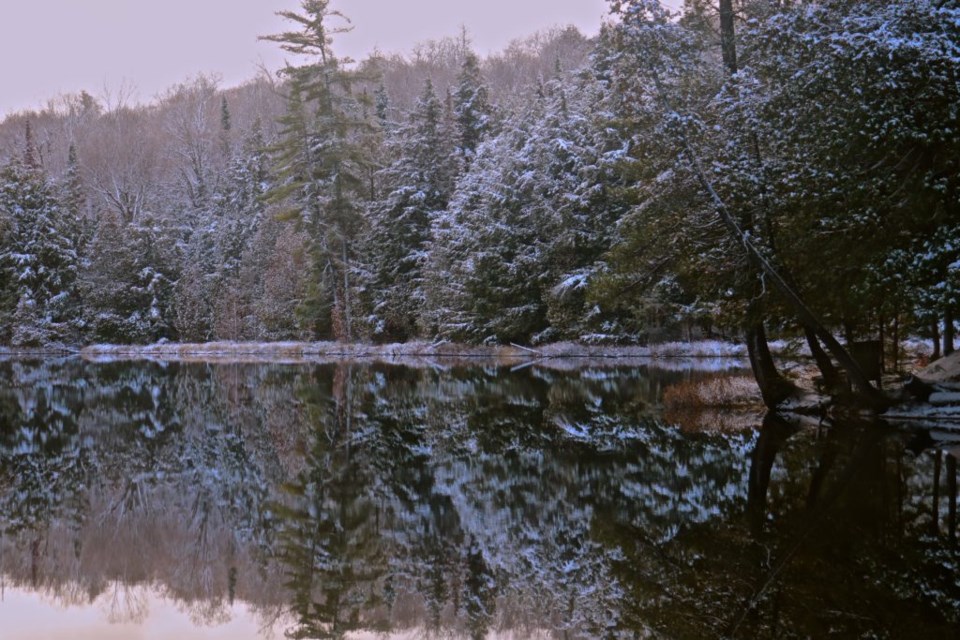
A trip to Muskoka for many in our area conjures up images of docks, tanning in the sun, and sunsets over endless green forests and glassy lakes. This description fuels the image of summer bliss ‘up north,’ as we refer to it in southern Ontario.
This weekend past, I had the privilege of seeing an iconic area of not just our province, but the world, in a very transitional and captivating state not experienced by many from our neck of the woods.
The benefits of visiting somewhere such as Muskoka in the least popular (or most awkward) month of the year, November, are noteworthy. Like rooting for the underdog, taking the time to consider a less traditional option can have surprising perks.
Why is November awkward? It’s certainly not summer weather. The fall colours are well past their peak performance, but snow hasn’t quite fallen to make it scenic and soft.
Not this early November weekend.
The Airbnb cottage we stayed in outside of Burk’s Falls was void of electricity and running water. We picked that by choice, aiming for a more classic deep woods experience.
When I hear the word Muskoka, I can smell the pine needles and hear the fat silence of those woods immediately. Feeling out those forests and lakes in their raw moods is a rewarding experience for the prepared, so that’s what we went for. Muskoka and the surrounding geographical area of the province is so special because it completes the circle of human attraction. The Canadian Shield, Canada’s most extensive geological landform, features bedrock and granite protruding dramatically to the Earth’s surface. This hard rock traps water in between all of its nooks and depressions, creating the iconic car window scenery of lake after lake as you drive up north.
We are attracted to natural beauty, and a certain ruggedness meets a certain stillness in this area of the province. It’s a place to relax, retreat, and explore our senses in a way that only nature can do. The lack of pure natural spaces in Niagara and southern Ontario may explain why so many of us itch to get up north.
Those who live up there are graced with these benefits, but can also face other socioeconomic and environmental challenges that come packaged with the “you live here full time” deal.
I feel like the greenery up there is the common denominator that makes it special for the summer warrior who embraces the sunny cottage life, as well as for residents tucked into those woods who work and live in four intense seasons of Canadian weather. Sometimes for generations, for some deep reason perhaps rooted in the outdoors factor.
Stepping into the local pub in Huntsville is like stepping into the trails of the area in November. It’s not busy. It’s gloomy and the lighting is moody, but the place is surprisingly cozy and you feel like you’ve got this little experience to yourself.
I look at the locals of the bar, dressed with boots that last for life and plaid jackets that never quit. And it’s not just the local bar, it’s in the traffic on the roads and the energy of the lineup at Timmies that feels different, too.
It’s relaxed up there in a way that we aren’t down here.
Despite being surrounded by the immediate and apparent necessities that smother us in southern Ontario, it is undeniably a different pace of life. Something happens along Hwy 11 heading north. There is a shift in both landform and culture, I daresay. Together, these factors create another shift that hits us at a more innate level. A sense of timelessness, letting our guard down, and being a little extra pure in Ontario’s wilds.
That’s how we see it, as we break free from the bottleneck traffic coming out of Toronto and the more densely populated southern Ontario. I have had nights ‘up north’ under a canoe, in a mansion cottage, a tent, a van, and a rundown motel. It never matters where, as the area is clearly famous and romanticized for a reason. I think the four hour drive is certainly influential on our culture and our life here in Niagara, as it is a part of many of us in some capacity.
I am forever curious as to what the natural change is once our southern Ontario bodies cross into the Canadian Shield.